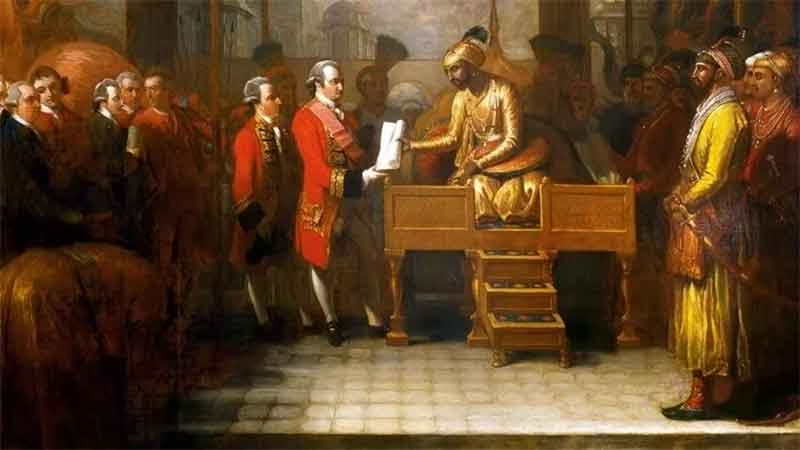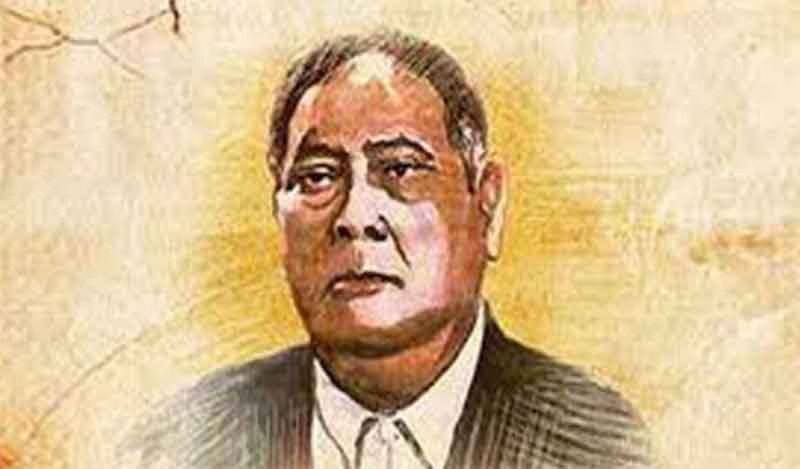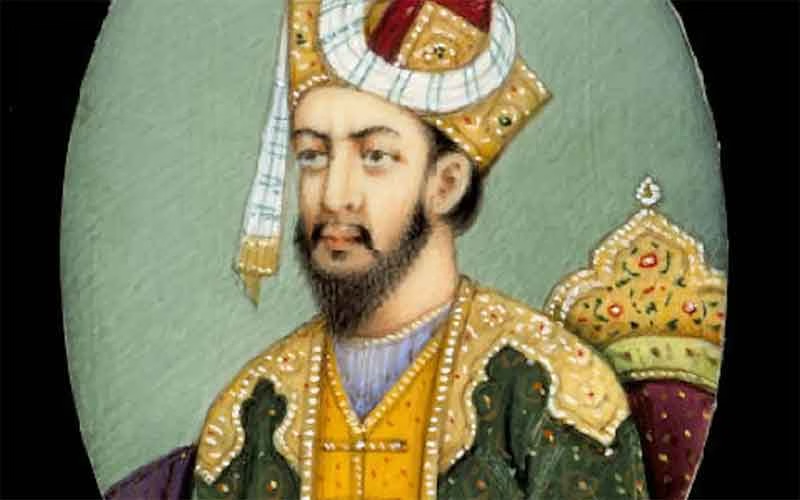
Introduction
The eighteenth century in India which coincides with the decline of the Mughal empire has for long been an area of intense debate among historians. Historians like Harbans Mukhiya, Satish Chandra and others have seen in this century a breakdown of the institutions of the Mughal empire like the Zamindari and Jagirdari exacerbated the decline of the Mughal empire already weak by the demise of Aurangzeb. This was a traditional view which held that since the superstructure of the Mughal empire crumbled, the other structures driving succour from it also started to gradually crumble. Except for two limited places overseas trade was not to be seen until quite late in the eighteenth century when Bengali silver was being used for trade with China. Regional centres emerged as the central authority to whom they were subservient withered away. It was in this process of dismantling of the Mughal empire that historians like C.A. Bayly through his book ‘Rulers,Townsmen and Bazars’ and Muzaffar Alam by depicting the case of Bihar and Awadh argued that the eighteenth century was not one of decline but rather of a strange intermix of continuity and change accompanied by growth. Here we shall look at this thesis which cites the emergence of corporate groups to suggest a growth and then look at how historians like Athar Ali and Irfan Habib respond to such arguments.
The Thesis of Change, Continuity and Growth
C.A. Bayly makes for an interesting read when he suggests that the most significant change during the eighteenth century was the introduction of money in cash form. Therefore first we shall look at the changes in order to better comprehend the concept of “growth” put forth by the revisionist school. According to Bayly, money became a crucial component of agrarian relations and so “the relationships of power between man and man, village and village, were reinforced and modified by control of cash.” From the rulers to the warriors everyone needed money and this encorporated men of commerce into the power-sharing as well. With an increasing role of revenue-farmers and merchants, a stable pattern of local power was forming between the state and agrarian society. Thus, according to him the central decay released forces so far suppressed,’benefited and consolidated the intermediate classes of society- townsmen,traders and service gentry- who commanded the skills of the market and the pen.’ Going by this argument,the institution of ijara or revenue farming is supposed to be acting as a great force of stability providing succour to the states. With the system of state revenue assignment collapsing with Aurangzeb’s demise, revenues began being farmed out to notables on a large scale. This was done in view of the ever increasing need of regular payments to the expensive armies which were increasingly being employed by the regional powers aspiring to set themselves up as a power to reckon with. According to Bayly,”the greatest of them were few in number: the main revenue-farmers in Awadh in 1770 amounted to some fifteen men,in Benaras, around thirty-six. Of the fifteen in Awadh sixty percent of the revenue was controlled by just two men- Almas Ali Khan and Bhawani Singh.” Then there were people like Sheo Lal Dube who were able to “transform themselves into local magnates and survive into the British period as zamindars.” Another powerful group which seems to have benefited from this wedlock of money and might for the upkeep of sovereignty were the revenue farmers and traders of Baiswara. The agrarian relation of these revenue farmers is brought out by emphasising the role of village traders and money lenders in parts which still went for the primitive form of assessment in kind. The revenue farmers used to keep cordial relations with these groups in order to “be able to sell their portion of the crop for ready cash.” The urban financiers also emerged as an affluent class in this period as it was these financiers who “advanced money to the revenue- farmers and stood as sureties (malzamins).” It used to be a practice that people issuing advances had a treasurer in the pargana itself. Two examples can be cited in support of this- Sheo Lal Dube, revenue farmer for Jaunpur carried out his transactions through a banker managing money collections of the village and the villagers of Chunar district paid their revenues through the agency of the local shopkeepers (bakkals).
Banking houses were another important player in this revenue play as it was against their dakhillas or the promissory notes that most of the rulers paid their armies. Omichands financing the nawab Sirajuddaula is an oft known example so instead of repeating that same tale we shall look for new examples which would probably show how at local levels too such cases had become a norm of the day. Fifteen large Lucknow and Banaras banking houses handled the entire 40 lakh rupees revenue from 1760-80. The British Resident himself admitted to the influence of the Agarwal house of Bhaiaram. Similarly in the 1770s, Kashmiri Mal, another banker, took revenue-farm for fourteen parganas of Jaunpur and Ghazipur district. A Jain banker, Lala Bacchraj, partner of Lala Kashmiri Mal, acquired for himself a central role in Lucknow court politics with the help of the British Resident. Similar examples can be cited for the bankers across the country with some of the prominent ones being- Omi Chand, Jagat Seth, Rao Durlabh, the Haribhaktis of west coast and the Marwaris(who are also given credit for building of Indian capitalist class by Goswami).
The next in line were the merchants who grew as an important group who through their Hundis made a substantive rule of how the transaction in the market would take place. Bengal silver was transported as far as Jaipur and Surat but from there gold could be brought to cover the subsidy of Nawab of Awadh if the silver was in short supply. With the growing need for money, the merchants found an increasing role for themselves in the political scene. Thus, through an indirect use of power the merchants could limit what rulers could do in the eighteenth century. The powers of the merchant-banker fraternity of Bengal and Hyderabad impressed him so much that Law de Lauriston, ex-governor general of French India saw them as the key group for any future alliance of French and Indian states against the English East India company. Apart from the Marwaris and the Jagat Seths, evidence comes also from Bareilly where the house of Lacchman Das survived the Mughal decline and the Rohilla power to the beginning of British rule.
We shall now move on to the corporations of townsmen, merchants and religious specialists whose autonomy was taken to be virtual civic self-government by C.A. Bayly. For Bayly, war and political change far from destruction, actually paved the way for the growth and development activities. He cites James Todd’s description of Rajasthan as an evidence for his argument. Todd wrote- “paradoxical as it may appear, there was tenfold more activity and enterprise in the midst of that predatory warfare, which rendered India one wide arena of conflict,than in these days of universal pacification.” The burgeoning activities took place with a “neglect of legislation” to go by Todd’s argument. An exclusion of even many officers of the Raja from the Jain merchants’ quarters shows the amount of autonomy achieved by these influential groups. Monetization of revenue demand and the growth of inland trade put trading groups in an advantageous position. Just like the merchant Mahajans of Gujarat, a Dhurnam Pacham or a general body of trading people came up in Mirzapur. It not only adjudicated disputes between people according to mercantile customs but also adjusted brokerage fees. A similar pattern was visible in Banaras where a Naupatti sabha( society of nine sharers) came up. This body of nine leading city merchants upset the Nawab’s plan of farming out revenue to Mir Rustam Ali by backing and ensuring the privilege being conferred upon Mansa Ram. The families in this sabha were from different trading backgrounds like Gujarati Brahman, Gujarati Vaishya, Oswal Jains and Agarwals. Certain castes or families were more proficient in certain trades like the Mehra Khatris were experts in cloth trade, Purabiya Agarwals led in grain trade and the Gujarati Banias in fine brocades. Because of an inextricable network being thus created between traders and the populace, common residential areas sprang up usually in the form of mohallas,single caste residential areas.
The ascetic orders like those of Bairagis and Gosains also played an important role in the eighteenth century economy. Their annual cycle of pilgrimage from Punjab to Bihar and Orissa involved them in moving money and goods. They were in fact the largest owners of urban property in Banaras, Allahabad, Mirzapur and Nagpur. Bayly estimates almost half a million Shaivite and Vaishnavite ascetics in north India in the last decade of the eighteenth century. The ascetic corporations had the advantages of religious status and power of organization. The Dasnami Nagas held a privileged position since Mughal days and with their resistance to an Afghan attack on southern Awadh in 1751 they reached an unmatched prestige. Following this, Gosain armies moved about in the countryside whom Bayly finds comparable to the Swiss mercenaries during Renaissance. The Gosains were revered equally by the Hindus and Muslims as the ‘Nawab invested one Gosain leader with the rank of four hundred Hazari.’ Their dominance was at full play during the Hardwar fair as described by Captain Hardwicke. In Mathura a combination of the Chaube Brahmins, regulating local trade and pilgrimage, and Vaishnavite monasteries (Kunjis) providing protection over long distance trade ran a kind of local government. The ascetic order of the Sanyasis set themselves on Bengal’s border. The Jat dominion of Bharatpur saw Vaishnavite orders of Ramawat and Nemawat amassed wealth and got the honour of conferring benediction and legitimacy on the Raja. Combined with the post of guru or spiritual preceptor to the ruler, the mahants became quite powerful. The Chitpavan Brahmins of the Deccan also created a virtual monopoly in high offices by their diplomatic potentials and their priestly position as they could bestow legitimacy upon those aspiring to be rulers. Even in the educational field, these groups ran colleges and centres for teaching like the Nanakpanthis had a college of their own in Patna. Shahjahani Sufis of Allahabad and the Firangi Mahal teaching seminary of Lucknow performed the same functions as those of corporations.
We shall now look at the service gentry which was emerging as another group in this century. They maintained patches of land rights and with them the influence in small towns even when the nobles looked for fresh pastures with the regional rulers. It was with the influence of such men that qasbah towns came up during the eighteenth century. With a mosque, schools, tombs and great gentry houses, a distinct quality was given to the qasbahs where the qazi was a central figure. Clan groups among the qasbahs emerged with those of Sheikhs of Kakori, Barah Sayyids,and the Sayyids of Jansath or Kara being the prominent among these corporations. As Bayly observes “the corporate status and pride of these communities was enhanced by the residence there of families of the holy men who had been settled on revenue-free grants of land by the Mughals and the regional rulers.”
Criticism of The Revisionist School
Athar Ali and Irfan Habib have quite categorically gone into the nuances of the thesis put forth by the revisionist school and with the prevalent paradoxes in those very thesis only have brought out the anomalies which accompany such theories. Irfan Habib puts it quite straight when he tells that the very nature of ijara or revenue farming as an institute tells us that the state functioning is out of place and it was an oppressive device. While earlier it was the state fixed revenue which was collected, with the revenue farmers coming in they could at any time arbitrarily increase the revenue demand upon the cultivator. With later evidence we are able to see how this practice put the cultivator under immense stress and kept on piling him with demands. How could then,revenue farming be an indicator of growth. The increasing role of merchant-bankers was also a by-product of the English arrival as it was with them that the practice of military fiscalism( a term coined by Martin Wolfe) started and with an increasing need for maintenance of a large army, money was required in huge quantity as well and this increased the role of merchant-bankers. Then for a decisive factor to find out the nature of the eighteenth century in India is not whether towns were coming up, bureaucracy functioning and commerce was coming up or not but whether these activities were taking place with a greater efflorescence than in the Mughal times i.e. the seventeenth century. For this, Bayly has made no attempt for comparison and even the evidence put forth by Muzaffar Alam is a very weak one. He compares the jamadami(estimated revenue) statistics in the Ain-i-Akbari with the eighteenth century revenue roll and concludes that the revenue doubled. He himself admits of the increase being cancelled out by a great rise in the intervening time so the evidence for growth itself stands on a shaky ground. Also, Bayly recognises the importance of the Mughal empire as more than just an umbrella of centrality but does not try to evaluate the impact of its decline with substantial evidence.
Subscribe to Our Newsletter
Get the latest CounterCurrents updates delivered straight to your inbox.
The cultural evidence of which Athar Ali talks is not talked about by both C.A. Bayly and Muzaffar Alam. The cultural failure is displayed by the “ruling class in not responding to the European challenge on the plane of technology and science.” It is actually this aspect which tells you the most about the level of growth achieved by a country and this, clearly suggests that at least growth was not the recurrent theme of the eighteenth century in India. In terming certain groups specially merchant-bankers as allies of British, Bayly makes an error not mentioning that it was a collaboration where one power i.e. the British were dominant and alliance was the only opportunity for survival to the merchant-bankers. The company allowed them to continue only because revenue collection was helped and remittances of funds arranged. Their activities were restricted so much more than in the previous regime as overseas trade as well as trade in muslin, silk, indigo and saltpetre was closed to them. What must also be remembered is that expansion of British power was not a successor to a Mughal or Maratha state but the expansion of colonial power, entirely different in its aims and objectives and nature from all previous regimes. The contradiction in Bayly is brought out by Andre Wink who first acclaims Bayly’s thesis of indigenous component in European expansion but in his epilogue concludes- “Maratha documentation shows that it was not the rapacity of revenue farmers but rather the impact of colonial government which interfered with the circulation and diffusion of money, credit and resources.” What Bayly fails to see is the impact of tribute which had clearly begun to impact India in a disastrous way. It closed all avenues for overseas trade which became non-existent and the only trade we shall see is the inland trade within regions of the country only. For anyone to still paint a glowing picture of change and continuity to show some perceptible growth in eighteenth century India one has to in the words of Irfan Habib “study the colonial economy without colonialism.” Thus, the thesis of change and continuity and the subsequent growth does not fully stand the scrutiny of evidence.
Bhavuk is a PhD Candidate at The Department of History, AMU















































